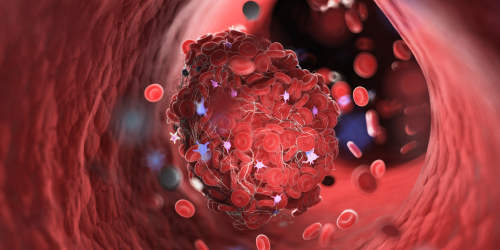Keeping good vascular health can mean life or death for some people. As veins are beneath the skin, you may wonder how to tell if your veins are healthy or not. Blood clots are one potential vascular health risk that you can’t positively diagnose without a doctor. With awareness, however, it is possible to spot the signs of a potential problem. Please read below to learn about blood clots and how to spot them.
What Are Blood Clots
Blood clots are a natural way the body stops bleeding, and this can be lifesaving in the right situations. After sustaining an injury like a cut, damaged veins release platelets into the bloodstream. Platelets are sticky and stick to each other and the edge of a damaged vein wall.
As more pile up and stick together, a sort of plug forms that stops blood flow. The plug grows larger as the body signals a chain reaction to send more platelets to the area. To finish it off, strands of fibrin form in the blood that mix with the accumulated platelets and form a net that becomes more durable.
In time, the injury will heal, and the fibrin strands end up dissolving. Flowing blood will dissolve the clot and take platelets away from the area.
What Causes Dangerous Clotting?
Dangerous blood clotting can occur when a clot does not dissolve on its own. If a blood clot breaks free from the area it formed, it can travel and become life-threatening. A clot flowing through veins can end up getting lodged in the heart or lungs.
If a clot gets stuck in these areas, it can prevent blood flow. In turn, this prevents oxygen and nutrients from getting to these organs and other parts of the body.
Dangerous clots can also form from cholesterol build-up. Cholesterol plaques form in arteries and can break open. If this happens, the plaque creates the same chemical reaction that a wound would to gather platelets. If a cholesterol plaque breaks open in the brain or heart, serious conditions like heart attack and stroke can occur.

Signs and Symptoms of Blood Clots
Many blood clots are not dangerous, but there is no way to know if you have one without medical screening. Blood clots also have the same set of symptoms that another disease would, making them hard to identify. There are even cases where there were no symptoms at all.
By learning the common symptoms of clotting issues, you have the best chance of identifying them and seeking medical help.
Types of Blood Clots
Arterial Clot – When clots form in the arteries, it is called an arterial clot. Symptoms of an arterial clot can be severe pain and body paralysis. These symptoms generally come on quickly and need emergency treatment. Heart attack and stroke possible and deadly.
Venous Clot – This type of clot occurs in the veins. They have a slower build-up, but that doesn’t mean they aren’t dangerous. Deeper veins with a clot can become life-threatening.
DVT or Deep Vein Thrombosis – DVT is a severe venous clot that forms inside a primary vein in the body. It is common to have DVT form in the legs, but it can happen in the arms, pelvis, lungs, and brain.
Symptoms Around the Body
Where a clot forms can determine the type of symptoms felt. While these symptoms can’t tell you for sure there is a clot, they may help you decide to see a doctor.
Leg or Arm Clot
- The most common location is in the lower leg
- Swelling
- Pain and Tenderness
- Warm sensation
- Reddish discoloration on the skin
- The size of the clot can make these symptoms extensive
Heart Clot
- This causes heart attacks
- Chest hurts
- Chest feels heavy
- Lightheadedness
- Short of breath
Abdomen Clot
- Pain in the abdomen
- Swelling
- These are symptoms of many other issues and can be hard to detect
Lung Clot
- This causes pulmonary embolism
- Sudden shortness of breath
- Chest pain
- Rapid heart rate
- Breathing problems
- Coughing up blood
Blood Clots and COVID-19
COVID-19 has caused many unexpected side effects. As the body fights a COVID-19 infection, it releases chemicals into the body meant to help. Unfortunately, these chemicals can disturb the delicate balance of internal workings. One issue is with the controls of blood thickness levels. In some patients, the blood gets too thick and begins to clot.
These clots are commonly occurring in the lungs and even the brain of patients. This side effect is deadly, and there is no way to predict who is at risk and who is not. Prophylactic blood thinners may be an excellent preventative for higher-risk patients.
If you experience a painful headache that does not go away with over the counter medications and have had COVID-19, check in with your doctor immediately. Calling 911 may even be the best course of action, to be safe. These clots can form even months after a patient has recovered and be just as dangerous.
Risk Factors
Blood clots can happen to anyone, but certain risk factors make the chances higher for certain individuals. If any of these apply to you, pay attention to your symptoms a bit closer.
- Recent lengthy hospital stay
- Major surgery
- Age 65 or older
- Travel that involves sitting for more than 4 hours
- Bed rest
- Obesity
- Pregnancy
- Family medical history of clotting issues
- Smoking
- Cancer
- Birth Control Pills
DVT Awareness
The risk of developing DVT is lowered dramatically with awareness education. Knowing about this serious blot clot condition can help people identify it so they may seek medical screenings.
Learn more about DVT.
You can lower your risk for DVT by making lifestyle changes. Giving up smoking, maintaining a healthy weight, and keeping blood pressure under control are all great places to start.
If you suspect you have deep vein thrombosis, contact the vascular surgeons at The Vein Centre in Tennessee to get professional testing. Testing is the only way to know for sure.
Screening for DVT will include one or more diagnostic tests to view and monitor the veins. Your surgeon may use ultrasound to view blood flow and check for any interruptions. A venogram is another way to view blood flow. This technique uses a dye that makes veins more visible during an X-ray. Another test is called the D-dimer test. Using blood, the D-dimer test checks for substances in the blood created when a blood clot breaks apart. The presence of these substances would indicate a risk for a blood clot, and a high level can mean a chance of DVT.
If you suspect you have a blood clot, it is essential to seek medical counsel. Blood clots can be deadly, so quick action can save you or a loved one’s life. Contact the board certified vascular surgeons at The Vein Centre in TN to discuss your vascular health. Our offices are near Downtown Franklin, Mt. Juliet, Brentwood, and Nashville. Visit us in Franklin, Belle Meade, or Mt. Juliet, Tennessee. To schedule, please call us at 615.269.9007. We would be happy to answer any questions you may have about our vein services.



